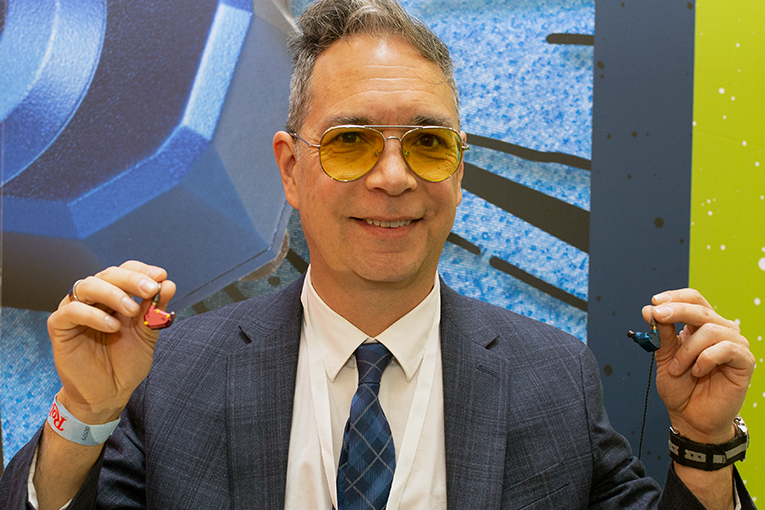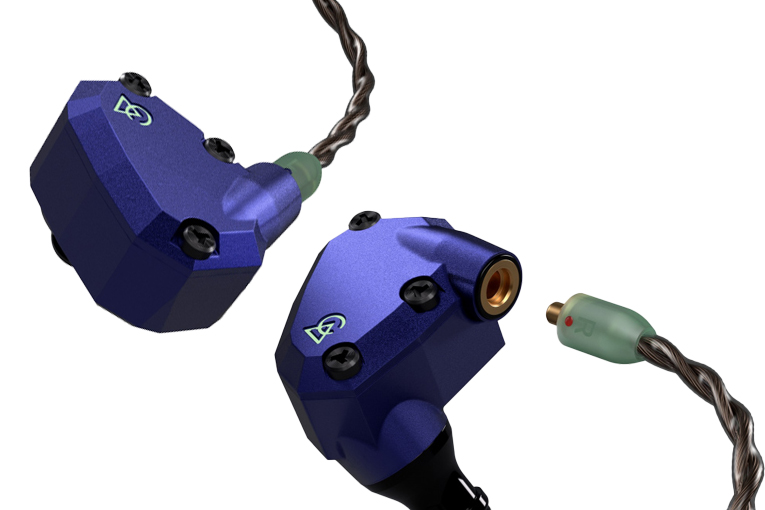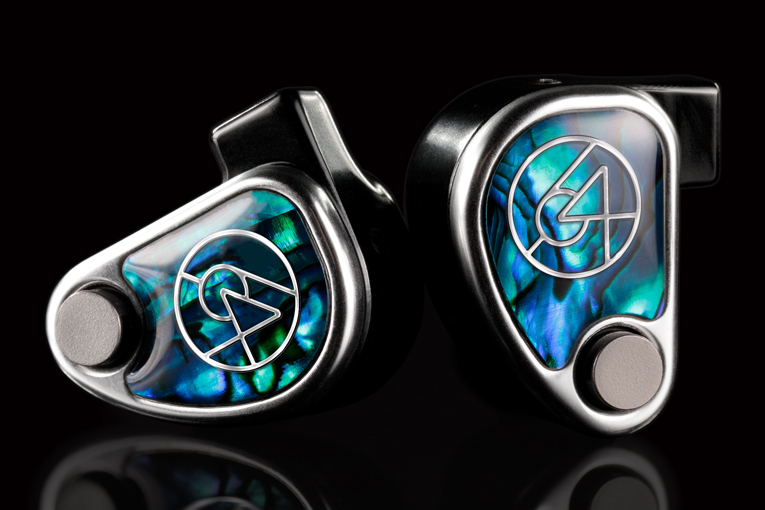In past editions of this series, I’ve interviewed professionals from Dan Clark Audio, PSB, Focal, and HiFiMan to learn their philosophies about voicing headphones. In those articles, the focus was on headphones rather than earphones, simply because earphones are at most a sideline for those companies. This month, we’re focusing on companies that specialize in earphones—which may seem similar to headphones, but in actuality, are radically different from an acoustical standpoint.
Almost all headphones use a single driver per earpiece, typically either a dynamic driver or a planar-magnetic design. Earphones—at least those embraced by audiophiles—are usually far more complex, employing multiple drivers (sometimes different types in the same earphone), crossover circuits, and intricate internal acoustics. For this article, I interviewed two audio pros who concentrate their efforts on earphones: Ken Ball, founder of Campfire Audio, and Vitaliy Belonozhko, founder of 64 Audio.
As always with this series, the focus is on voicing, rather than on the specifics of each company’s products. You can find in-depth reviews of these companies’ products using the search bar above.
Ken Ball, Campfire Audio

Brent Butterworth: Is there a certain target curve to which you voice your products?
Ken Ball: The process is completely different depending on whether it’s headphones or earphones. For earphones, we do it a little differently than most audio companies. We don’t really have a target curve for any product; we let the inherent strengths of the driver shine. We minimize the weakness of any component while maximizing its strengths.
Most of our earphones are multidriver, and the process changes when you throw in many different drivers. We choose a cluster of drivers to make the final model, and the whole process can take several months. Instead of having target curves, I have a library of individual driver characteristics. I measure them all individually. I’ll overlay the responses of those individual drivers—low, medium and high—so I can get an idea of what the potential product’s response will look like. We try to use sort of a harmony effect; we choose drivers that work together well. That’s really, really hard, because you have to change drivers out to find ones that work well with each other.
From there, I’ll determine the driver assembly. Then we create a 3D boot to hold the drivers and the acoustical plumbing.
This is where the magic happens for Campfire. We do a lot of our tuning based on the creation of this boot that has the plumbing in it. I avoid using passive components and crossovers as much as possible. That’s unusual for an earphone company—we try to do most of the tuning via physical plumbing. I don’t think we’ve ever used a resistor—the moment I use a resistor, it sounds bad. There are lots of little tricks we do with chambers and resonators, without using a crossover or a lot of passive components. We rely heavily on 3D printing to create these acoustical analog tuning mechanisms.

BB: So you start with measurements then move on to listening?
KB: There are two phases. The first phase is frequency response measured with an acoustic analyzer. Once we get the frequency response smooth, without any weird anomalies or suckouts, then we start all over in the listening phase. And we do boot adjustments in that phase. A frequency response that looks good may not sound good. The ear is so much better at nuances and textures, and measurement gear can’t even come close.
I don’t believe in using the Harman curve. What I want to do is cater to people’s different likes, and so we create different flavors of sound. Even if I create an earphone that someone likes, I know someone else will hate it. I want to create a product that’s perfect for somebody. The last two earphones we designed, the Mammoth and the Holocene, couldn’t be more different.
BB: How is the process different with headphones?
KB: We start with the driver. I have a phenomenal driver manufacturer. He gives me many different drivers and I pick the one with the most promise, then I’ll say “Give me more sensitivity at 3kHz” or whatever, then he refines it and we put it in an enclosure and start working with the physical tuning—the air volume, damping, etc. In my opinion, it’s a lot simpler than designing a multidriver earphone. And the earpad makes a big difference. We were very happy with the openness and naturalness we got with the Cascade [Campfire Audio’s only headphone model to date], but it’s not directly comparable to the result we get with our earphones.
BB: How would you describe the sound of your earphones?
KB: While they are all different, they share common DNA, like the lack of passive components, the lack of complexity, and the lack of unnecessary drivers. There’s a big “driver number war” going on with earphones right now, and I think that can reduce the quality of the product. Basically, our earphones all sound very natural, with wide dynamic range. Like a camera has a range of white to black, and our earphones have that same philosophy because we avoid all the extra components. To me, the complex crossovers create a small sound that has no delicacy.
When you listen to music through headphones and earphones, it’s like you have like a ball of sound inside your head. Our earphones create a big ball.
Vitaliy Belonozhko, 64 Audio

Brent Butterworth: Do you have a specific target curve to which you voice your earphones?
Vitaliy Belonozhko: I’ll tell you a story about how we came up with our curve. God gave us ears to use to judge whether something sounds good or not. A lot of people rely on measurement, and they’ll form their opinion about whether something is good based on those measurements. I’m not one of those people.
Industrial designers don’t design with a ruler; they have an eye for design. It’s the same in audio, you have an ear for audio, and you have equipment that helps you in a few aspects, like making comparative measurements. Through our work, we arrived at a curve that sounds natural to me. And when we pulled up the Harman curve, it was actually quite similar.
But ultimately, I rely on the emotion that the earphones give me. The voicing has to be musical—although just as in the studio, where you sometimes choose microphones to brighten the sound or thicken the midrange, there are cases where you might want to alter the sound a bit. Our earphones that are geared toward vocalists and guitarists are going to have a little more presence in the mids, but you can still listen to an album on them, because it’s a subtle boost and it’s not harsh or shrill.
BB: So you voice the pro models differently from the consumer models?
VB: In most cases. The audiophile is never going to listen at the volumes the stage musician listens at. So we have to take the equal loudness curves into account. We will try to go for warmer sound on the pro products, so when you push them hard it’s still musical. For audiophile models, we voice more for clarity, transparency, and micro detail, which is what that consumer wants.

BB: How would you describe the sound of your earphones?
VB: We go for a smooth top end. I’m not a fan of a bright top end. Making it smoother on top helps prevent ear fatigue and is more musical. Our mids are natural, we don’t push them for a mid-bump to add presence. Most of our stuff is a little on the warmer side. I love that sound of vinyl, that warmer tone, that tone that can kind of hug you and be a gentle massage to your eardrums. Nothing in our lineup is mid-heavy or bright.
I have another engineer, also named Vitaliy, who does a lot of the tuning for me. I used to do it all myself, but the company got big enough to where I couldn’t do all that. So he’ll come up with something he thinks is good, I’ll listen to it, and we’ll make corrections. I’m kind of the idea generator. I’ll wake up in the middle of the night and think of something we should try. Then I have a few reliable people in the industry I’ll send prototypes to, about half a dozen people. I don’t rely entirely on my own ear, not because I don’t think I can do it, but when you’re doing a lot of products, you can get lost in what you want. And you also want to make products other people like.
BB: When you measure earphones, what do you look for?
VB: When you’re measuring in-ears, in my opinion, there’s not a coupler out there that’s really true to how you hear it. So it’s really for documentation purposes. If we like the sound, we measure it, and everything has to match that golden trace, say plus or minus 1dB. And we can go back later and compare that with previous models we’ve designed. We don’t rely on the measurements to tell us what sounds good.
People sometimes ask for frequency-response graphs. We are hesitant to give them, for one reason: The graph you see does not correspond with the way you measure a speaker. With speakers, you want to see a graph that is reasonably flat. With earphones, we have to compensate for the pinna and some of the ear canal, so that graph doesn’t look flat at all. And we’d need to have, like, a four-hour session with you to explain this. If we made earphones that measure flat, it would sound like wilted cabbage—really boring!
. . . Brent Butterworth







